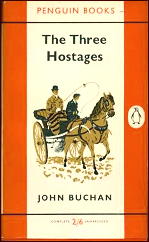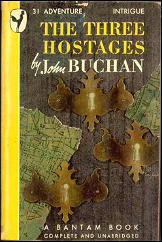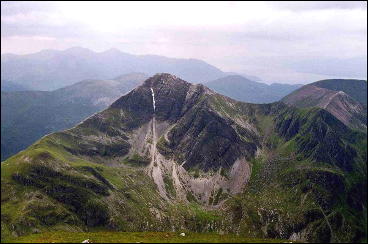Mon 12 Apr 2010

JOHN BUCHAN – The Three Hostages. Hodder & Stoughton, UK, hardcover, 1924. Houghton Mifflin, US, hc, 1924. Reprinted many times, in both hardcover and paperback, including Bantam #31, US, pb, April 1946; Penguin, UK, pb in dj, 1955 (both shown). TV movie: BBC, 1977, with Barry Foster & Diana Quick as Richard & Mary Hannay; director: Clive Donner.
Having recently reread Greenmantle (reviewed here ), I’m now rereading some of the other Hannay novels. While some will certainly disagree, I view The Three Hostages as a mystery-thriller because there is a mystery to be solved: where are the three missing people and who is behind their abductions?
The book opens a couple of years after WWI. Sir Richard Hannay and Mary Lamington are now married with a young son. They reside in Fosse Manor, a nice touch given they first met when she was staying with her aunts at the Manor while engaged in a bit of undercover work herself.

One evening the Hannays’ friend Dr Greenslade visits and their conversation turns to how to write a “shocker”. Dr Greenslade’s theory is the author should take three apparently unconnected things, invent a connection, and dream up a problem to solve involving the connection. His example: “an old blind woman spinning in the Western Highlands, a barn in a Norwegian sæter, and a little curiosity shop in North London kept by a Jew with a dyed beard.”
In the real world ugly international doings are afoot and eventually they intrude into Hannay’s household. Members of the families of three great men — “the daughter of the richest man in the world, the heir of our greatest dukedom, the only child of a national hero” — have been kidnapped and are being held as hostages by a “combine” whose members are outwardly respectable but which is using the disaffected across Europe and elsewhere to further their own concerns, including fraud, profiteering, and even murder.
Though known to the authorities, if members of this combine are captured too soon, the hostages will doubtless be executed and certain delicate political matters in the balance upset.

By a twist of fate Dr Greenslade’s literary example serves to aid Hannay and his friends get on the track of the villains in a race against a deadline at which they can only guess.
My verdict: Was Buchan following Dr Greenslade’s advice, I wonder? Hannay has quite a puzzle to solve and the first half of the book follows his attempts to make sense of the sole clue: six lines of doggerel sent to each of the three great men.
There is more intelligence work and less physical action in this novel and the slow working-out of the mystery is convincing. Mary Hannay, while mostly off the page, plays a role near the end that is both gripping and believable and received a loud hurrah from here!
Etext: http://gutenberg.net.au/ebooks03/0301231.txt
Editorial Comment: Shown below is Stob Ban in the Mamores, one of the peaks that might have been used as a model by John Buchan. For more mountain scenes and commentary on where they might have shown up in Buchan’s work, go here.

April 12th, 2010 at 5:34 pm
Not one of Buchan’s works I’ve read, but Mary, you’ve certainly convinced me that I ought to, and soon!
— Steve
April 12th, 2010 at 7:50 pm
Buchan’s clue here is a bit of classical Latin that was so convincing scholars actually tried to trace it down — only to find it was original to Buchan.
There are some who consider this the finest hour of the Hannay series, since it takes him away from his usual adventure and forces him into the role of detective, and Mary is absolutely right about Mary Hannay. The scene where she confronts the villain is a stunner.
Dominic Medina is the greatest of all Buchan’s villains. In fact, he could almost be a hero with just a touch less ego.
Of course it would have been enough that Buchan was a noted scholar, writer of popular fiction, and political figure, but as Governor General of Canada he healed a rift between the US and Canada and the UK and Canada assuring a major part of the alliance that led to the victory in WW II and along the way established the most important literary award in Canada, the Governor General’s award.
Incidentally he later apologized for the minor racial comments in this and some of his other books, and went on to become an early voice decrying fascism.
There really isn’t a literary figure like him in American politics; scholar, poet, politician, statesman, and popular entertainer. All having been born to a poor middle class Scots Calvinist family.
He was the only writer to have two books on that famous list of John F. Kennedy’s favorites that appeared in LIFE and helped drive Ian Fleming onto American bestseller lists.
THE 39 STEPS was recently adapted on MASTERPIECE THEATER, and a major film adaptation by Robert Towne (CHINATOWN) is due in 2011).
I don’t think the BBC adaptation of THE THREE HOSTAGES is available on DVD. I saw it when it came out, and while Barry Foster wasn’t my ideal of Richard Hannay, it was quite good.
April 13th, 2010 at 2:12 pm
It is a superb book, and a creepily up to date one. Not only do we have political kidnapping, but there is also a warning about the dangers of media manipulation from the character Macgillivray. By the way, I wonder if Buchan is the inventor of the cliche of the retired agent who is reluctantly coaxed back into harness for ‘one last job’.
If you haven’t already read it, I would recommend Buchan’s historical/political thriller THE FREE FISHERS. Hardly anyone seems to have heard of it, but it’s one of my favourite Buchans.
April 13th, 2010 at 9:37 pm
Bradstreet
I agree about THE FREE FISHERS, for some reason not as well known as it should be. As for Buchan being eerily predictive, he had already topped this when in 1910 he wrote the novel POWER HOUSE and predicted the rise of Fascism and what he later called “the rational fanatic.” Graham Greene calls it the first modern spy novel.
In many ways THE THREE HOSTAGES is his best book since it combines elements of the detective story and thriller.
Ironically one of his books, GAP IN THE CURTAIN, is the story of a group of people who see a newspaper from one year in the future and how their lives are effected by what they see.
I don’t know if we can credit Buchan with the agent coming out of retirement story. I’d have to check LeQueux and Oppenheim who wrote spy stories long before Buchan, but it is possible. Buchan didn’t invent the spy story — only gave it the form we know now. Clarence New’s Diplomatic Freelance was running in POPULAR from WWI on, and some of real life spy A.E.W. Mason’s stories deal with secret service work.
April 14th, 2010 at 1:29 pm
I remember when I first read THE POWER HOUSE, thinking that it was a sort of urban THE THIRTY-NINE STEPS. Leithen is a good character, constantly irritated that his ordered life is being upset by stumbling into this conspiracy, but determined to bring it to an end. As had been mentioned, Leithen is perhaps the closest to the real Buchan, and rather close to his heart, I’ve always suspected. He’s one of the would-be poachers in JOHN McNAB. It has no murders, no great conspiracy, and concerns a world of which I have no experience, but I’ve always loved it. It’s a terrible shame that Buchan is only known as the author of THE THIRTY NINE STEPS to the general public, as he was so much more than that.
April 14th, 2010 at 8:13 pm
Bradstreet
I agree about Buchan, he’s much more than a simple storyteller (which is no mean thing in itself). My favorite of the Leithen books is THE DANCING FLOOR, which finds Leithen enamored of a young woman (the splendidly named Kore Arabin) and fighting to save her from a Greek fertility cult.
He was also the hero of SICK HEART RIVER (MOUNTAIN MEADOW), the last of Buchan’s great series of books and his fictional portrait of the sacrifices he made to his health and future happiness in order to take on the tremendous job of Governor General of Canada.
Relations between Canada and the US and Canada and the UK were at an all time low under the rule of popular but difficult Canadian Prime Minister Mackenzie King, and Buchan’s choice for the job was so universally applauded that he made the cover of TIME when given the job (When’s the last time a Canadian political figure was on the cover of TIME?). From his appointment to his death he used his popularity and considerable charm and skill to first heal the wounds between King and the UK then build ties between King and FDR who ended up fast friends.
By his death in 1941 one of the greatest and longest lasting alliances in history had been forged, and Buchan’s always frail health had failed. His death was universally mourned, but Churchill, FDR, and others all credit him with a large role in helping to assure the final victory in the Second World War.
And like Leithen, his most biographical character (Hannay was based on South African general Tiny Ironsides and Sandy Arbuthnot on T. E. Lawrence and Aubrey Herbert),he was a solicitor, and eventually Solicitor General of the UK, and a knight of the realm, Buchan made first Baron of Tweedsmuir.
Of the books outside of the Hannay/Leithen titles WITCH WOOD is an outstanding novel about witchcraft in sixteenth century Scotland, BLANKET OF THE DARK about the reign of Henry II, and SALUTE TO ADVENTURERS which takes place in part in the Kentucky of Daniel Boone, are all outstanding. Also worth finding his novellas tied as a novel PATH OF THE KING, and his short story collection WATCHER BY THE THRESHOLD which influenced both H. P. Lovecraft and Robert E. Howard.
April 15th, 2010 at 3:25 pm
Politician, diplomat,solicitor, great writer, self-made man…Whenever I read a biography of Buchan I always end up feeling like a lazy slacker!
I would just like to recommend the Dickson McCunn series: HUNTINGTOWER, CASTLE GAY and HOUSE OF THE FOUR WINDS. They’re breezy and charming adventures, and McCunn is very different from the expected Buchan hero. He’s a retired, avuncular looking grocer, who hides the soul of a true adventurer beneath his tweeds. Charm is a very difficult quality to define, let alone create, but the books are charming.